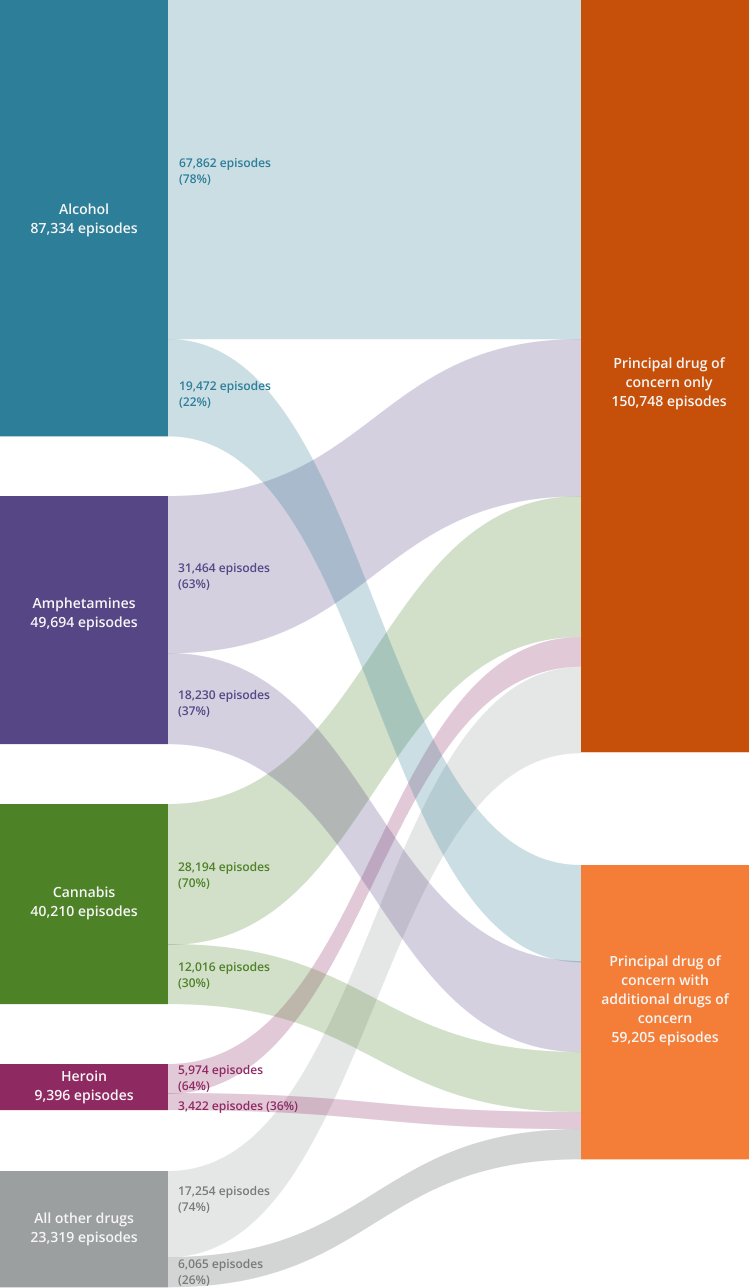Drugs of concern
People may seek alcohol and other drug (AOD) treatment services for use of one or several substances (including alcohol). The principal drug of concern (PDOC) is the main substance that the client stated led them to seek treatment. Clients can also nominate up to 5 additional drugs of concern, though these are not necessarily the subject of any treatment within the episode.
This section presents information on treatment episodes provided to clients for their own AOD use only. It is assumed that only the person using a substance themselves can accurately report their principal drug of concern. Therefore, these data are not collected for people who are seeking treatment for someone else’s drug use.
This section focuses on treatment episodes provided for alcohol, amphetamines, cannabis and heroin as the PDOC. These 4 drugs were consistently the most common principal drugs of concern across Australia in the 10-year period up to 2021–22. For detailed information on each drug of concern, refer to the technical notes.
Key findings
In 2021–22:
- The most common principal drug of concern was alcohol (42% or 87,300 episodes), followed by amphetamines (24%), cannabis (19%) and heroin (4.5%).
- 4 in 5 treatment episodes for amphetamines were for methamphetamine as the principal drug of concern (80% or 39,900 episodes).
Over the 10-year period to 2021–22:
- The top 4 principal drugs of concern have remained consistent with amphetamines replacing cannabis as the second most common principal drug of concern from 2015–16.
- Alcohol remains the most common principal drug of concern, increasing from 63,800 to 87,300 episodes over this period.
- Treatment episodes for amphetamines as the principal drug of concern almost tripled between 2012–13 and 2019–20 (22,300 to 61,000), although this has declined since then (49,700 in 2021–22).
- Treatment episodes for heroin as a principal drug of concern fell from 8.3% to 4.5% (or 12,800 to 9,400 episodes).
Drugs of concern and treatment provided
In 2021–22, over 9 in 10 treatment episodes provided to clients were for their own AOD use (92% or 209,953 episodes) (Table OV.1). Among these episodes:
- The most common principal drugs of concern were alcohol (42% of treatment episodes), amphetamines (24%), cannabis (19%) and heroin (4.5%) (Table Drg.1).
- Clients reported at least 1 additional drug of concern in over one quarter of treatment episodes (28%).
- The number of additional drugs reported was most commonly 1 (18% of episodes) or 2 drugs (6.7%).
- Cannabis (11% of episodes), nicotine (9.1%) and alcohol (7.2%) were the most common additional drugs of concern (tables Drg.1, Drg.2, Drg.3).
- For the 4 most common principal drugs of concern, the most common treatment setting was non-residential treatment facilities (ranging from 63% to 72%) (Table Drg.8).
In the 10 years to 2021–22, the total number of treatment episodes for clients’ own drug use increased from 155,151 to 209,953 episodes (Table OV.1). Among these episodes across the period:
- Alcohol remained the most common principal drug of concern each year, and treatment episodes increased by 37% over this period (from 63,800 to 87,300 episodes). The proportion of treatment episodes for alcohol in relation to all other drugs of concern fluctuated, falling from 41% in 2012–13 to 32% in 2015–16, before rising to 42% in 2021–22.
- Treatment episodes for amphetamines as a principal drug of concern more than doubled since 2012–13 (22,300 to 49,700 episodes), although this has declined since 2019–20.
- 4 in 5 (80%) episodes for amphetamines were for methamphetamine as the principal drug of concern, increasing from 18% since 2012–13 (from 4,050 to 39,900 episodes).
- Treatment episodes for heroin as the principal drug of concern fell from 8.3% to 4.5% (or 12,800 to 9,400 episodes).
- Treatment episodes for cannabis fluctuated, peaking at 45,000 episodes in 2015–16. In relation to all other drugs of concern, cannabis treatment episodes were most prominent in 2014–15 when they constituted 24% of all episodes (Table Drg.5).
Fluctuations in certain principal drug treatment episodes in particular years may be due to administrative anomalies in the data. For example, the drop in all treatment episodes in the 2014–15 and 2016–17 collection years may be partly related to system changes resulting in under-reporting or partial reporting of the number of episodes in some jurisdictions (See the Data quality statement for further details).
Figure DRUGS 1: Closed treatment episodes for own alcohol or drug use, by principal drug of concern and additional drugs of concern, 2021–22

Note: Totals might not add to 100% due to rounding.
Source: AIHW Alcohol and Other Drug Treatment Services National Minimum Dataset Tables Drg1 and Drg.2.


